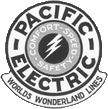
Route: Built from 3rd & 'D' to Base Line & 'D' by San Bernardino Valley Traction in 1901; it was the first electric line in San Bernardino and opened for service on 22 February 1902. Extension north to Arrowhead Springs Hotel was built 1906-1907 and opened on 15 March 1907. The 1924 power shortage caused temporary suspension of service, but restoration took place on 2 January 1925. Final abandonment of passenger service took place on 1 September 1932. Freight service continues to date, composed entirely of tank cars to and from bottling works at Arrowhead Springs; this service was dieselized in 1943.
Operation: Passenger service as of 1 February 1924 provided six trips per day in each direction, giving a headway of approximately two hours during morning and evening peaks (!) with three hour service midday. The old wooden car left San Bernardino at 7:27 and 11:27 AM—and 1:42, 4:27 and 5:42 PM; returning, the car left Arrowhead Springs at 8:04 and 10:04 AM and 1:04, 2:19, 5:04 and 6:19 PM.
Distance and running times: From San Bernardino to Highland Avenue was 2.55 miles, covered in 15 minutes; to Severance was 2.45 miles, was made in 11 minutes; to Arrowhead Springs was 2.25 miles, covered in 10 minutes—giving a total of 7.25 miles and 36 minutes.
Revenue for this line for 1926 was $3,412, and cost of operation was $4,400; deducting taxes ($175) resulted in a net out-of-pocket loss from passenger operation of about $200 annually.
In 1913, this line carried 64,010 passengers; in 1924 the total dropped to 17,677—although the territory had build up greatly.
Equipment: San Bernardino Valley Traction 100 (PE 1300) was the regular car until succeeded by PE 1310 about 1 February 1912; 1310 had magnetic brakes needed to handle severe grades encountered. PE 1311 was also used. A Birney was assigned to the line for a time. Freight motive power was one of the 1550 Class until 1922, then 1509 and 1591 until dieselization.
Miscellany: A substation was built at Arrowhead in 1907 "to supply sufficient power for the big cars which climbed the steep grade..." Fire destroyed it on the night of 22 April 1911, and a portable substation was sent out from Los Angeles; it took four hours for San Bernardino Valley Traction's big freight motor to haul the portable substation up to Arrowhead; power from all the city lines was concentrated on the Arrowhead line for that particular run. The rebuilt substation was placed in service on 6 May 1911.
General Manager Merrihew (San Bernardino Valley Traction), speaking on 16 June 1910, had the following to say regarding the Arrowhead line: "Mr. Huntington has that Arrowhead line on his hands, which was built against his judgment, and it is one of the reasons why the San Bernardino Valley Traction is not paying dividends today. There is a line which cost $180,000, running to a hotel of $100,000, capable of caring for eight people. Never in a thousand years will the line pay, unless there is water secured for the territory about it and it is settled up."
In July 1912 PE began surveys which led to extending the line a quarter-mile to the hotel itself and made available to tank cars of the Arrowhead drinking water. A bottling works was established and for many decades the "water bottles" as the tank cars were known, became a familiar sight in and around San Bernardino.
A quarry at 49th Street was served by a spur track 1.23 miles long, built in 1909 and removed in 1915.
Combos 1310 and 1318, the usual cars on this line in the early days, were regarded by school kids as "cattle cars", according to Bill Garner. Mr. Garner recalls: "We boys would all ride in the baggage compartment, which was to the rear as a rule, while the girls rode in the passenger compartment. We would make the conductor mad by blowing the rear whistle, ringing the bell, signaling the motorman or rocking the car. Another stunt in the afternoon was to get torpedoes and place them on the track in front of the cars before they left for home. Sometimes we would get real mean and jerk the trolley wire off. I remember when the 1318 was the San Bernardino Valley Traction 100; we kids really thought she was some car."
| 1925 service: | 5 round trips between Highland Avenue and Arrowhead, plus three to Severance and 6 to Crusher. (Effective 15 Jan 1925) |
| 25 March 1925 service: | Four round trips from Pacific Electric Station (San Bernardino) to Arrowhead, plus a round trip to Highland Avenue from Arrowhead. |
| 10 July 1930 service: | One round trip from Pacific Electric Station to Arrowhead plus 3 round trips from Severance to Pacific Electric Station and others from Highland Avenue to Crusher and Arrowhead. |
| 1 November 1930 service: | 5 round trips from Pacific Electric Station to Arrowhead plus a trip from Arrowhead to Highland Avenue and from Highland Avenue to Severence. |
| 1 June 1931 service: | 32 round trips daily between Crusher and Highland Ave.; one round trip daily from Arrowhead to Highland Avenue No through service—shuttle service only. |
| 25 November 1931: | Three round trips daily, San Bernardino-Arrowhead. |
Bill Garner recalls the old days; "The kids of today do not known what they missed. We kids used to ride to school from all over the valley. The school cars came in off the Highland, Redlands and Colton lines and there would be quite a string of them moving up 'D' Street in the morning and down in the afternoon. In 1922 traffic got so heavy that a siding about 250 yards long was built for them at 18th Street Special cars were run for high school plays, athletic events, etc."